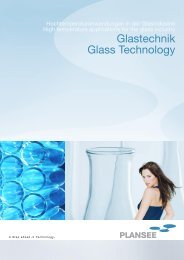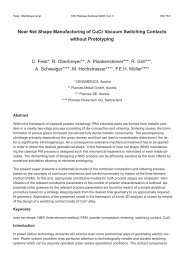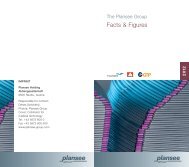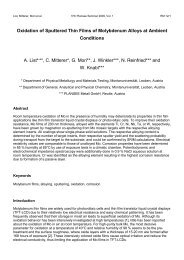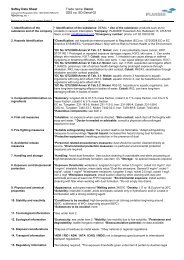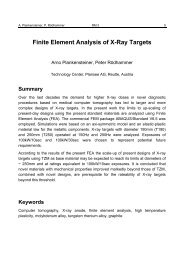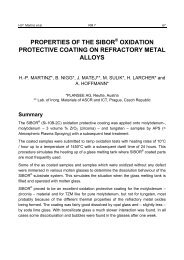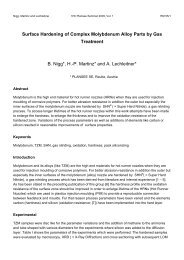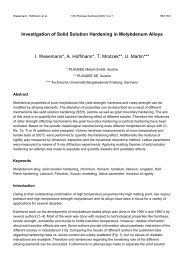Fracture Toughness of Polycrystalline Tungsten Alloys
Fracture Toughness of Polycrystalline Tungsten Alloys
Fracture Toughness of Polycrystalline Tungsten Alloys
You also want an ePaper? Increase the reach of your titles
YUMPU automatically turns print PDFs into web optimized ePapers that Google loves.
RM 21/2 17th Plansee Seminar, Vol. 1 Gludovatz, Wurster et al.<br />
Introduction<br />
Most studies related to the ductility <strong>of</strong> tungsten and tungsten alloys were performed in the sixties and seventies<br />
by e.g. Raffo et al. [1]. Since fracture mechanics was not well established at that time the studies on<br />
fracture toughness were scarce. Riedle and Gumbsch [2, 3] extensively studied the fracture toughness <strong>of</strong><br />
tungsten single crystals in the nineties. The effects <strong>of</strong> crystallographic orientation, crack growing direction,<br />
loading rate and temperature were investigated. Compared to the single crystal, the fracture toughness <strong>of</strong><br />
polycrystalline tungsten is not well examined yet.<br />
We started an extensive investigation <strong>of</strong> the fracture toughness <strong>of</strong> pure tungsten (W), potassium doped<br />
tungsten (AKS-W), tungsten with 1wt% La2O3 (WL10) and tungsten-26wt%-rhenium (W26Re). The results<br />
<strong>of</strong> few selected microstructures are presented in this paper. A very large effect <strong>of</strong> the microstructure especially<br />
below the ductile to brittle transition temperature was observed. The investigations indicate that<br />
the change from transgranular to intergranular cleavage fracture plays an important role. Especially crystallographic<br />
analysis are presented to improve the understanding <strong>of</strong> interaction <strong>of</strong> these fracture processes.<br />
This paper is also submitted to the 12 th International Conference on <strong>Fracture</strong> - July 12-17, 2009.<br />
Experimental<br />
The fracture toughness <strong>of</strong> W, AKS-W, WL10 and WRe were investigated by means <strong>of</strong> 3-point bending -<br />
(3PB - fig.1-a), double-cantilever beam - (DCB - fig.1-b) and compact tension specimens (CT - fig.1-c).<br />
All specimens were manufactured out <strong>of</strong> rods during different stages <strong>of</strong> the processing route. Figure 1<br />
shows specimens for tests in rolling- (RD) and tangential direction (TD), additional ones were prepared to<br />
investigate the materials in normal direction (ND). The experiments were performed in the range <strong>of</strong> -196 ◦ C<br />
to more than 1000 ◦ C.<br />
In order to examine the local variation <strong>of</strong> the fracture resistance DCB-specimen (fig. 2-a) with a length <strong>of</strong><br />
30mm, a height <strong>of</strong> 3.5mm and width <strong>of</strong> 7.5mm respectively CT-specimen with a length <strong>of</strong> 7.5mm, a height<br />
<strong>of</strong> 3mm and a width <strong>of</strong> 6mm were manufactured out <strong>of</strong> W-, AKS-W-, and WRe-rods. The notches were<br />
prepared with a diamond-saw, refined with a razor blade and fatigue-precracked under cyclic compression.<br />
The areas in front <strong>of</strong> the crack-tips were scanned by electron backscatter diffraction (EBSD) after a heat<br />
treatment <strong>of</strong> about 2000 ◦ C for an hour in hydrogen atmosphere (fig. 2-b). Some specimens were then<br />
loaded under tension within the range <strong>of</strong> stable crack growth (fig. 2-c). After that the previously scanned<br />
areas were scanned again by EBSD (fig. 2-d) to quantify changes <strong>of</strong> the grain orientation in the obtained<br />
orientation imaging maps (OIM).<br />
The tests performed at room temperature were done with a microtensile-testing machine <strong>of</strong> the company<br />
Kammrath & W eiss while the tests at elevated temperatures were done by use <strong>of</strong> a ZW ICK universaltesting<br />
machine. The analyses were made by use <strong>of</strong> a Zeiss 1525 scanning electron microscope equipped<br />
with an EDAX EBSD system.<br />
Figure 2: Experimental setup to investigate the local variation <strong>of</strong> the fracture resistance: Position <strong>of</strong> a DCB-specimen<br />
in a AKS-W rod (a). Scanning the area in front <strong>of</strong> the crack-tip by EBSD (b). Apply a tensile load on the specimen<br />
(c). Scanning the previously scanned area again (d).



